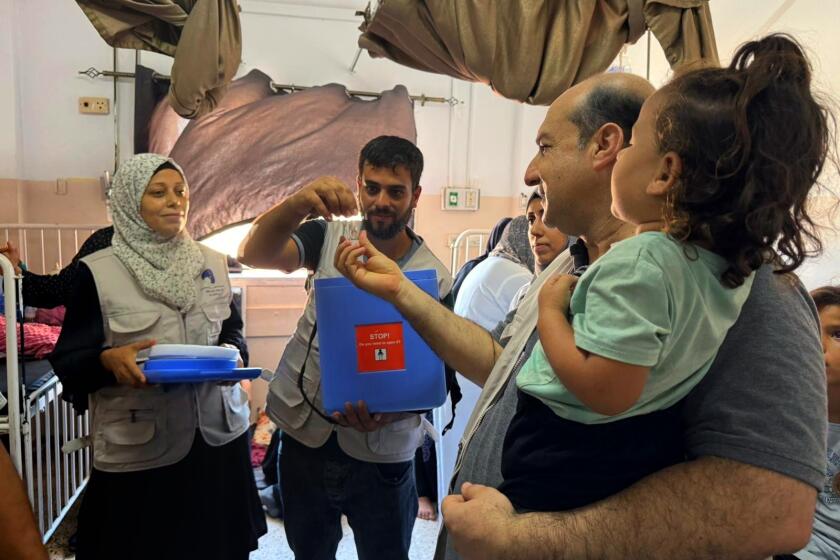Furloughed U.S. Workers’ Absence Felt : Government: As partial shutdown drags on, many jobs deemed nonessential at its start begin to appear far more necessary with each passing day.
WASHINGTON — Fifteen days ago, Gunter Thomas, a medical technician who operates lasers at the National Cancer Institute, was deemed a “nonessential” federal employee and was furloughed in the government’s partial shutdown. But unless he’s permitted to return to work this week, a cancer patient scheduled for experimental laser surgery could go untreated.
At the Centers for Disease Control and Prevention in Atlanta, a small crew of scientists--considered “essential” workers--continues the critical work of analyzing viral flu samples. But they are fast running out of reagents--the chemicals needed to conduct their lab tests--because none of the so-called nonessential clerks is there to handle the special orders.
The story is the same at the U.S. Trustee’s office in Los Angeles. In normal times, hundreds of bankruptcy filings are completed daily. But now the painful process of liquidation has been put on hold because more than half of the office’s nonessential clerks, paralegals, attorneys and financial analysts have been furloughed.
*
As the partial shutdown drags into a record-breaking third week, many jobs that seemed nonessential at its start begin to appear far more necessary with each passing day, particularly as the strain grows for those who have worked throughout the ordeal.
At the Commerce Department, for example, copy machines sit broken with no one to repair them. The print shop is closed, and the credit union won’t disburse cash because too few security officers are on duty.
“Our main phone isn’t ringing, and we can’t get anybody to service it because they’re all on furlough,” said Michael Goodin, who works in the legislative and intergovernmental affairs office of Commerce Secretary Ronald H. Brown. “The other day, one person with a big copying job went floor to floor looking for an open copying center. They are all closed. And many of the copy machines are broken.”
The shutdown has produced personal hardships as well. “This building is three blocks long, and only one door is open--the one farthest from my Metro [commuter train] stop,” Goodin continued. “These situations take away minutes of your time that add up over the long run during the day.
“It’s the little things that are getting to us now, and they are building into a desperate situation.”
Hundreds of miles away, Nancy Cox, a physician and chief of the CDC’s influenza branch, shares the frustration. She is working frantically against a deadline to gather information that will help U.S. vaccine manufacturers know what flu strains to expect during the 1996 flu season. The work must be done now or the vaccine supply won’t be ready in time. She and her colleagues must identify the first of three probable strains--painstaking work--and their findings must be confirmed by labs in London and Melbourne, Australia.
If the 1996 flu vaccine effort is crippled, it won’t be because the CDC scientists are missing; it will be because the support staff is. The researchers can’t stop what they’re doing to conduct the time-consuming chores typically--and more efficiently--performed by others, including the processing of shipments and orders.
*
“We’re headed for a real problem in terms of getting shipments [of viral flu samples] out of CDC,” Cox said. “We have some strains from China we need to get out. We exchange agents that might potentially serve as the basis for vaccine candidates with a number of different labs to cross-check our data. We collaborate with folks in the U.K. and Australia, and need to get these samples to them. We can’t because the staff that normally does the shipping is on furlough.”
Moreover, she said, “we’re getting the viruses and growing them up, but we need to have those reagents. We’re starting to run out of things because there is no one to do the orders. We are approaching an emergency situation.”
Hoping to get some of their workers back into the office, CDC officials were trying to change the affected employees’ status from nonessential to essential--a complex process. A similar effort was underway to get laser specialist Thomas back to work at the NCI, according to Anne Thomas, his wife and the spokeswoman for the institute’s parent organization, the National Institutes of Health.
Although the lasers he operates are essential to the cancer surgery planned for this week, Thomas happened to fall under the nonessential category when the shutdown began. And despite the bureaucratic designation, the cancer surgery cannot be done without him.
At the U.S. Trustee’s office in Los Angeles, few cases are moving through the system.
*
“We’re basically just handling emergencies,” said Marjorie Erickson, one of only two assistant trustees in the office. “We’re not able to do the routine things that will be difficult to catch up on.”
Workers in the L.A. office serve seven California counties and process about 10% of the bankruptcy cases filed annually in the United States. Nearly 7,000 came through the office last month alone. Now thousands of pieces of mail sit untouched and the phones go unanswered.
At the San Diego headquarters of the U.S. Border Patrol, workers wondered how they would keep supplies moving to outlying offices without the usual number of clerks, who help deliver basic goods--from computer disks to pens to plastic forks--to facilities in San Diego, Orange and Riverside counties.
At the NIH, 2,000 new funding grants, scheduled to be mailed Monday, will not go out. The mail room is closed. And there is no money anyway.
“This could be a make-or-break point for a young researcher,” said Tom Flavin, an NIH spokesman still on duty. “The person who was going to find the cure for melanoma or some other life-threatening disease will say: ‘That’s it. I’m gonna bag it. I’m out of here.’ ”
Cimons reported from Washington and Helfand from Los Angeles.
More to Read
Sign up for Essential California
The most important California stories and recommendations in your inbox every morning.
You may occasionally receive promotional content from the Los Angeles Times.









